So...First post is all business, but I joined the forum because I've always wanted to fab my own pedals and lighting, and maybe link up old equipment to make it do things it was never meant to do. 
Back to business-Skip to the *'s for abbreviated info, but Basically I'm an idiot and while distractedly talking,
*I hooked my 9v battery up BACKWARDS to the AEQ SS preamp in my ('03?) Ibanez AEL-20.
*No sound, a little burnt component stink. Done. Upon inspection no capacitors or anything seemed to be blown or charred, but
*the only visible damage was to the chip in the center of the board, which had a crater burnt into it, (pictures attached)
so I figure why not spend a few cents to try replacing it? There are no other preamps units that fit in this mounting location on this guitar, apparently they only made the SS for a few years before switching to the SST. I'm proficient in most wiring and soldering, and I've replaced components on pcboards before, but I'm not good with knowledge of their function (yet). As I spend time on this forum I'm sure it will be just like learning about cars and bikes.
My questions are:
*What is the correct part to replace this amp./component with?
*And what other problems should I prepare for after hooking up 9v backwards to this setup?
The chip is apparently a LinCMOS op.amplifier. The numbers printed on it (thankfully still readable) appear to be🙁Texas Instruments logo)
34CRJ5T
TLC2264C
Another thread on this site lists the AEQ SST as having a TLC2264 as well, so that tells me I'm on the right path, but the Texas Instruments site doesn't specify a Letter at the end of TLC2264. A few other sites I've looked at list such options as "TLC2264D... PA", and other ones I can't remember.
*Does the last "C" designation differ from "A" or "PA" etc? And does it matter that the top line of numbers is totally different? ("43W25LCW" as supposed to "34CRJ5T"
The only site that seems to have "C" is:
https://www.utsource.net/ic-datasheet/TLC2264C-63269.html?adgroupid=10062095734&keyword=tlc2264c&adposition=1o3&gclid=CjwKEAiAmdXBBRD0hZCVkYHTl20SJACWsZj9KVQIGwbxO2aOJxOwRBZkKfjjc6NwOjuUgc2SFGP3zBoCjH3w_wcB
Thanks for dealing with the information overload, but I like to be thorough.
I just want to make sure I'm getting the right part, and going through the correct steps. I know it'd be much simpler to just get another kind of preamp, but I REALLY don't want to cut the hole bigger and have to remount and fab a plate to make it not look janky AF.
THANKS!!!
-Josh
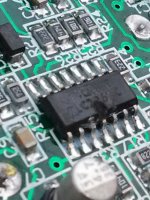
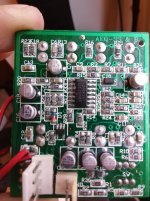
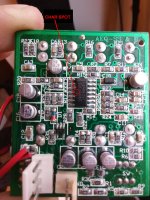
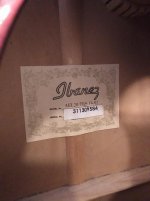
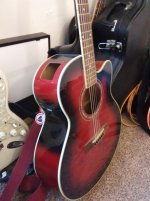

Back to business-Skip to the *'s for abbreviated info, but Basically I'm an idiot and while distractedly talking,
*I hooked my 9v battery up BACKWARDS to the AEQ SS preamp in my ('03?) Ibanez AEL-20.
*No sound, a little burnt component stink. Done. Upon inspection no capacitors or anything seemed to be blown or charred, but
*the only visible damage was to the chip in the center of the board, which had a crater burnt into it, (pictures attached)
so I figure why not spend a few cents to try replacing it? There are no other preamps units that fit in this mounting location on this guitar, apparently they only made the SS for a few years before switching to the SST. I'm proficient in most wiring and soldering, and I've replaced components on pcboards before, but I'm not good with knowledge of their function (yet). As I spend time on this forum I'm sure it will be just like learning about cars and bikes.
My questions are:
*What is the correct part to replace this amp./component with?
*And what other problems should I prepare for after hooking up 9v backwards to this setup?
The chip is apparently a LinCMOS op.amplifier. The numbers printed on it (thankfully still readable) appear to be🙁Texas Instruments logo)
34CRJ5T
TLC2264C
Another thread on this site lists the AEQ SST as having a TLC2264 as well, so that tells me I'm on the right path, but the Texas Instruments site doesn't specify a Letter at the end of TLC2264. A few other sites I've looked at list such options as "TLC2264D... PA", and other ones I can't remember.
*Does the last "C" designation differ from "A" or "PA" etc? And does it matter that the top line of numbers is totally different? ("43W25LCW" as supposed to "34CRJ5T"
The only site that seems to have "C" is:
https://www.utsource.net/ic-datasheet/TLC2264C-63269.html?adgroupid=10062095734&keyword=tlc2264c&adposition=1o3&gclid=CjwKEAiAmdXBBRD0hZCVkYHTl20SJACWsZj9KVQIGwbxO2aOJxOwRBZkKfjjc6NwOjuUgc2SFGP3zBoCjH3w_wcB
Thanks for dealing with the information overload, but I like to be thorough.
I just want to make sure I'm getting the right part, and going through the correct steps. I know it'd be much simpler to just get another kind of preamp, but I REALLY don't want to cut the hole bigger and have to remount and fab a plate to make it not look janky AF.
THANKS!!!
-Josh





Electrically it is a TLC2264C, any remaining letters describe the package. Look at the data sheets. The C means it is a commercial temperate range IC. You can pay more and get extended range if it will be used say in a jat plane where temperatures get down to -40 degrees C. You guitar probably stays within the 0-70 degree C range.
You have a small outline surface mount package, so the D suffix is what you want. The N suffix is the plastic DIP. Even more letters? If it adds an R on the end that means they come on a reel - on tape all in a row. leave the R off and they come in a plastic tube.
The other line of numbers is a date code or lot code, like the number on the bottom of a can of corn or peas.
You have a small outline surface mount package, so the D suffix is what you want. The N suffix is the plastic DIP. Even more letters? If it adds an R on the end that means they come on a reel - on tape all in a row. leave the R off and they come in a plastic tube.
The other line of numbers is a date code or lot code, like the number on the bottom of a can of corn or peas.
OPA x277 is a modern replacement with similar specs you may find easier to buy.
OPA4277 http://uk.rs-online.com/web/cp/1003865,4618914,4618914P/?sra=p&r=t
I just swapped the DIP packaged TLO64 in my (old) Ibanex GSR200 Bass for the OPA2277.
Datasheets are online. Supply voltage, supply current and noise are what you are looking at for a battery pre-amp. LINCMOS is old tech and you may struggle to buy now.
OPA4277 http://uk.rs-online.com/web/cp/1003865,4618914,4618914P/?sra=p&r=t
I just swapped the DIP packaged TLO64 in my (old) Ibanex GSR200 Bass for the OPA2277.
Datasheets are online. Supply voltage, supply current and noise are what you are looking at for a battery pre-amp. LINCMOS is old tech and you may struggle to buy now.
Last edited:
The OPA may be a superior IC in some regard, but the type he posted is in stock at Mouser, and not hard to get.
Both the TLC 2264 and the OPA 4277 are available from Mouser, but the OPA is about 4x more $$$$. The OPA 4277 also has MUCH less distortion, about 4 db less noise, outstanding Common-Mode rejection, but also draws twice the current.
DUDE. @Enzo @dogshome @dotneck335 - thank you SO much! You guys ROCK. This is the BEST experience I've ever had on a help forum, and I am STOKED to be a part of it. Most people I've experenced would be like "noob. forget this guy."
I have all kinds of questions and ideas about creating LED light chains for live instruments, using old cell phone cameras and things that were never meant to be used for what I want to use them for, mainly in music performance.
I'll follow up and let you all know how the change goes, and THANK you for suggesting the diode, I'll order now! CHEERS!
I have all kinds of questions and ideas about creating LED light chains for live instruments, using old cell phone cameras and things that were never meant to be used for what I want to use them for, mainly in music performance.
I'll follow up and let you all know how the change goes, and THANK you for suggesting the diode, I'll order now! CHEERS!
So what results will I see from this unit drawing twice the current, and how will it affect the system?
Just shorter battery life or should I install anything else in conjuntion?
I'm traditionally an automotive/motorcycle guy, so I know basics and can chase problems, repair,and solder most things, and modify some, I just need to translate all that over to circuitry.
Just shorter battery life or should I install anything else in conjuntion?
I'm traditionally an automotive/motorcycle guy, so I know basics and can chase problems, repair,and solder most things, and modify some, I just need to translate all that over to circuitry.
You will see minimal change. Both use very little current. uA are pretty small!
If your battery lasts 5 years with the CMOS op amp (500uA), it will last maybe 2 years with the modern (low noise, low distortion) equivalent.
If your battery lasts 5 years with the CMOS op amp (500uA), it will last maybe 2 years with the modern (low noise, low distortion) equivalent.
Last edited:
Help!! can anyone repair my AEQ SS? This was a great forum.... lots of talent and info. Could any of you guys fix my preamp? no resources where I live, but I can send it anywhere. I would be sooooooooooo grateful! Jeff
- Status
- Not open for further replies.
- Home
- Live Sound
- Instruments and Amps
- Ibanez AEQ SS Repair